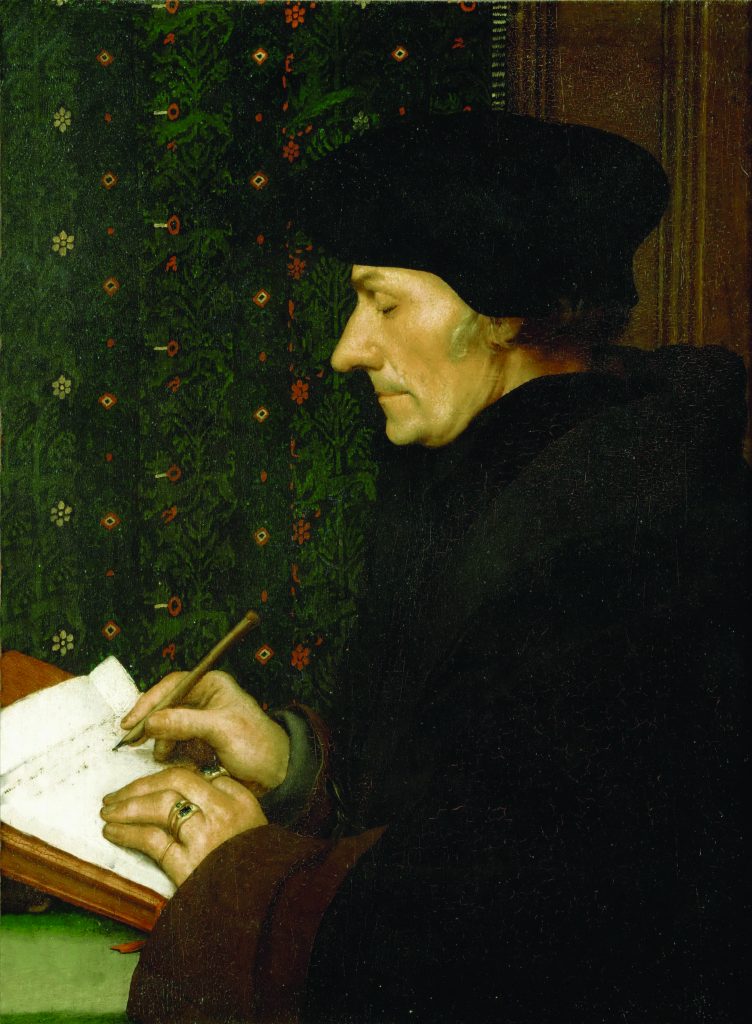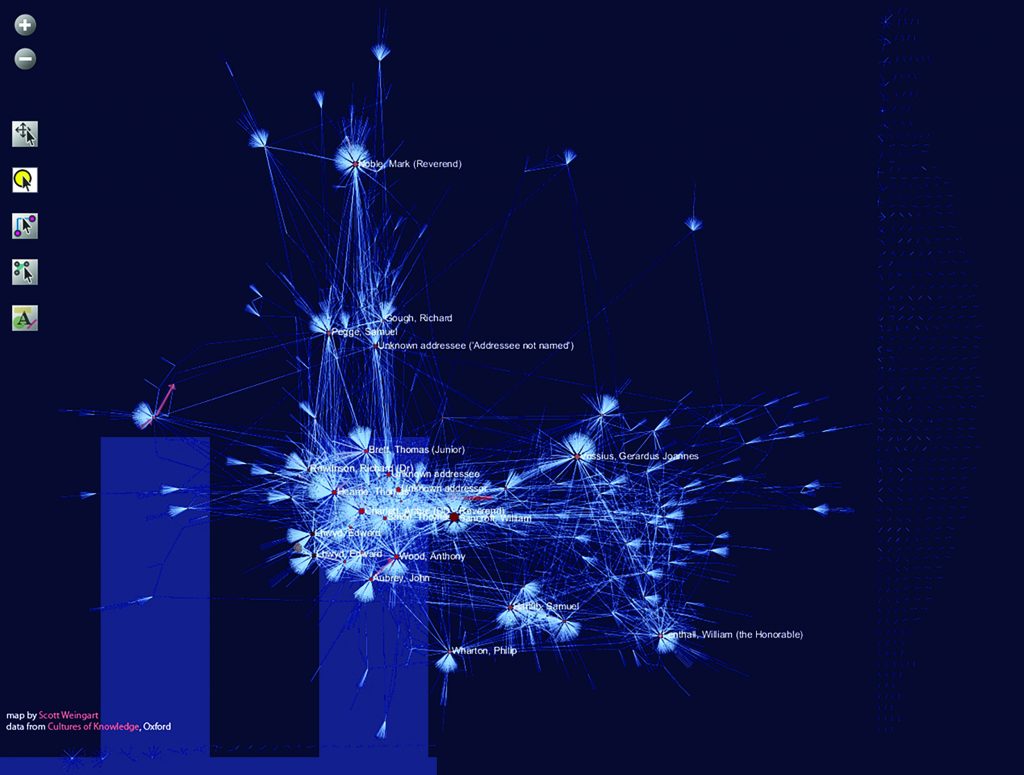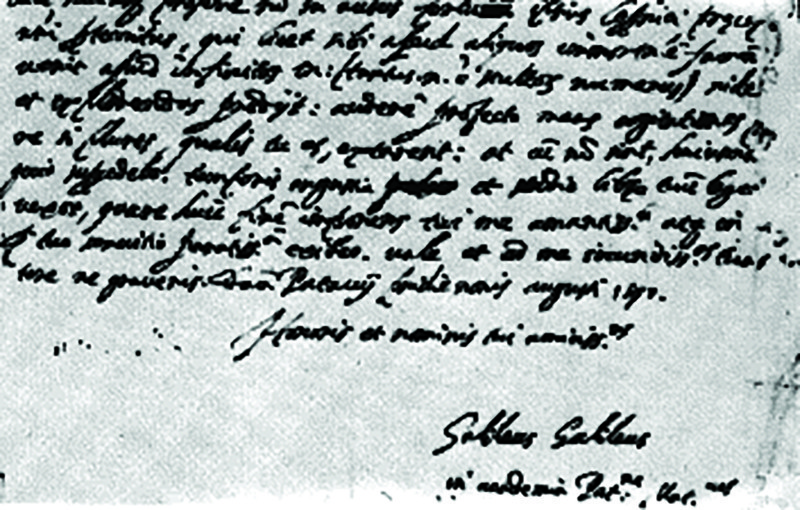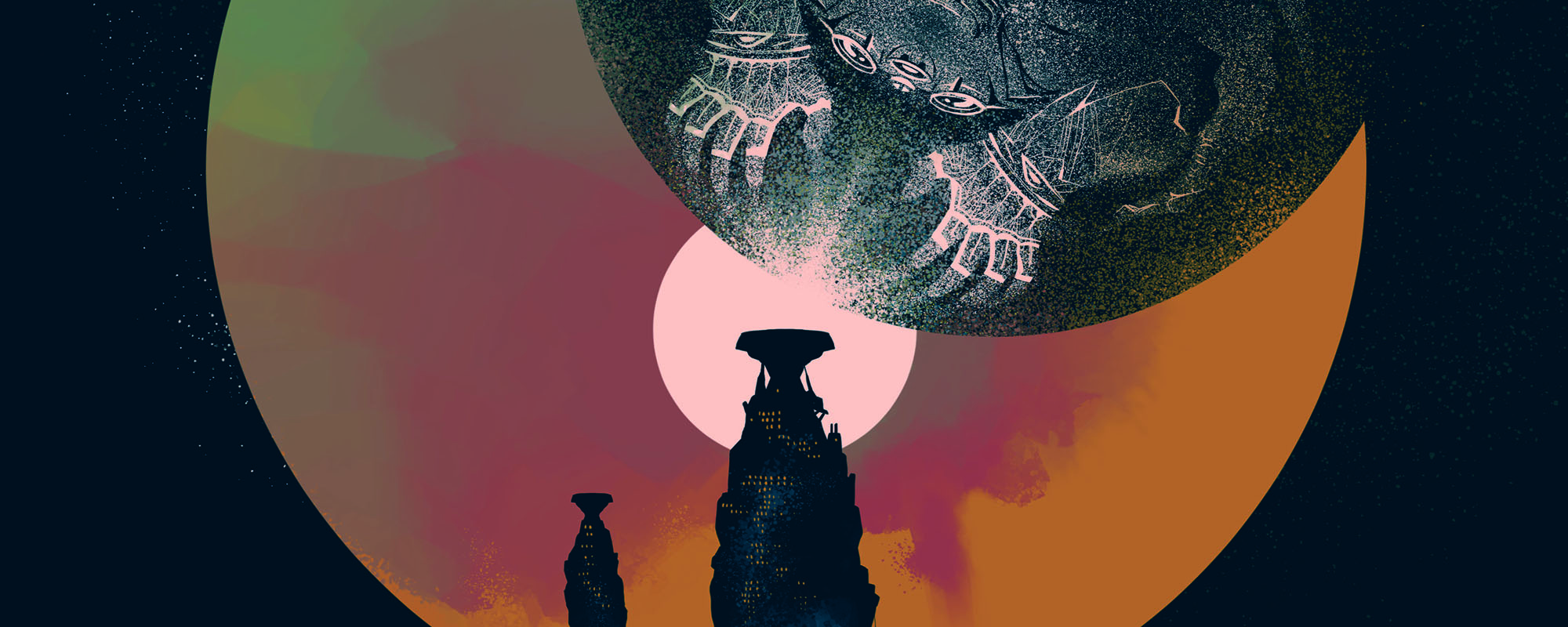Scholars and digital technologists are developing new tools to study the exchange of letters amongst past intellectual networks that shaped European ideas, values, and institutions.
Dr Jean-Paul De Lucca writes.

Johannes Gutenberg’s invention of the printing press in the mid-15th century unleashed a revolution by facilitating the circulation of ideas, information, propaganda, and discoveries like never before. Knowledge was democratised as it moved beyond the confines of traditional seats of learning to reach wider audiences. Authors of philosophical, scientific, theological, literary, philological, and historical works had greater and easier access to a broad array of sources that influenced their own works, and they, in turn, influenced the works of others. The surge in production and dissemination of printed books and pamphlets spurred and shaped the great developments of early modernity, from the Reformation to the scientific revolution.
Running in parallel with the printing revolution was another, often overlooked revolution: that in postal communication, which allowed scholars and scientists to establish a virtual community that became known as the republica literaria, or the Republic of Letters. The collections of letters of great luminaries, including those who have since been relegated to the darker corners of history, played a crucial role in Europe’s intellectual and cultural developments between 1500 and 1800.
The power of letters
Scholars and students of the history of philosophy and science have generally relied on books as their preferred mode of presenting, commenting and connecting ideas. In recent years, however, intellectual history has focused increasingly on the context in which such ideas emerged and on the originators’ biographies. This gradually paved the way for collaborative projects looking at the relationships and activities of groups of thinkers. Known as prosopography, this analysis of collective biography has developed into a valuable methodology in the study of early modern societies.
A broader viewing of the intellectual networks that grew from the 1500s onwards sheds light on the cross-fertilisation of ideas resulting from such relationships. As historians became more aware of how relationships were forged through epistolary exchanges that transcended physical boundaries (whether faraway countries or prisons), intellectual history and intellectual geography intersected at the understanding of the past in terms of both time and space.

Letters have gradually gained prominence as valuable primary sources. They occupy a unique place in exchange networks at a time when printed books were often subject to censorship or self-censorship. One famous example concerns a major text in the history of modern philosophy—René Descartes’ Meditations on First Philosophy (1641). Keen on avoiding a backlash, the French philosopher decided to seek the formal approval of theologians from the Sorbonne before its publication. Although ostensibly dealing with metaphysics and theology, we now know through a private letter that Descartes’ intention was to smuggle in his physics, which, like Galileo’s, opposed the prevalently accepted physics of Aristotle. Writing to Marin Mersenne from Leiden on 28th January 1641, Descartes confided in the friar-mathematician that ‘between us, these six Meditations contain all the foundations of my physics.’ He then begs him not to say a word about this, for it would make it harder to obtain the approval of ‘the supporters of Aristotle’. This letter leaves no doubt about Descartes’ true intentions, and provides a crucial interpretative key for reading and interpreting the Meditations. In those same weeks, Descartes engaged in an intense correspondence—through the Paris-based Mersenne—with the English philosopher Thomas Hobbes, who had decided to exile himself to the French capital. An edited version of that correspondence came to light some months later as the third of a series of objections and responses published as an appendix to the Meditations.
The contents of thousands of letters—many of which were never intended for public consumption—do not only provide us with precious information and insights that enhance our understanding of their authors’ works and ideas. Some of them also share ostensibly more mundane information about their personal lives or seemingly minor events (such as the burning down of someone’s library, or personal disputes). Even then, important nuggets of information are to be found. Machiavelli’s private letters to Francesco Vettori, for instance, are peppered with gossip, reports on the author’s sexual exploits and rather demeaning insults towards common acquaintances. One of these letters, however, provides an important clue for dating The Prince.
The dating of works is just one of the many reasons why epistolary collections are a wealth of information. Letters often indicate the location of their authors and recipients at the time of writing. They also suggest the approximate time it would have taken the letters to reach their destination. All this information has proven extremely useful to the scholars putting pieces of the puzzle together. The long exchange of letters between two protagonists of early modern science, Galileo Galilei and Johannes Kepler, is a case in point.
The two thinkers had been corresponding for quite some time when on 9th August 1610, Kepler wrote to Galileo informing him of an astronomical observation he made using a borrowed telescope. In the same letter, he asks Galileo to send over one of his own telescopes. This letter had taken less than ten days to reach Padua from Prague, because on 19th August, Galileo sent a reply, telling Kepler that he had no telescope available at that moment. He did assure him, however, that he planned to build others after his impending move to Florence to become the Mathematician and Philosopher of the Grand Duke of Tuscany. How could letters reach their destination in such a short time in 1610? The answer lies in another letter that suggests that Galileo was at the time availing himself of what is today still a fast and safe postal service: the diplomatic bag. The Florentine ambassador to Prague, Giuliano de’ Medici, wrote to Galileo on 6 September 1610 to inform him that he had handed Galileo’s letter to Kepler. We also learn through Giuliano’s letter that Kepler was willing to replace Galileo at the University of Padua, a move that never materialised.
Big data to the rescue
The sheer volume of letters dispersed in countless archives across Europe makes it difficult to gain insight into the broader picture of the real network of intellectual connections at any given time in the early modern period. Throughout the last century, some historians of philosophy and science, as well as archivists, have gone through great pains to trace, identify, and collate entire epistolary catalogues and collections.
In the pre-digital age, the arduous task of letter-hunting relied exclusively on physical archival research and resulted in print publications of collections of letters. It was generally a solitary enterprise carried out on the fringes of individual scholars’ research interests. Reassembling these letters, as it were, could hardly illustrate the broad and dynamic environment of exchange they had created centuries ago. Printed transcriptions and facsimiles are often presented in chronological order but fail to capture the spatial dimension that includes, for instance, the epistolary exchange running in parallel between recipients and their other correspondents. The network of connections is simply impossible to visualise and understand through print editions, not least because the partiality and selectivity of indexes limits their searchability.

The information on Machiavelli, Galileo, Descartes, and many others is not new. Their letters have been resting in archives for centuries and have also been published in edited volumes. The novel approach lies in the fact that this information is being gradually brought together on online platforms. The digital revolution proved a great asset in this mission. If I wish to pick names or words in the letters by philosophers such as Erasmus of Rotterdam, Hugo Grotius, Tommaso Campanella, or Jan Amos Comenius, the metadata in the digital editions of their letters on dedicated websites now works for us in ways that print editions never could. The emergence of digital humanities as a collaboration between the humanities and ICT experts has led to increased access and efficiency in archival research. It has also paved the way for new research questions and opened avenues for further development of new scholarly methods based on multilateral collaboration. One key feature of digital technology is that unlike print editions, the temporal and spatial elements can be brought together and understood at the click of a button.
Reassembling the Republic of Letters
Reassembling the Republic of Letters (COST Action 1310) is a collaboration that brings together humanities and digital communication technology researchers from 33 countries. Their goal is to develop an open-access, open-source, transnational digital infrastructure capable of facilitating the radically multilateral framework needed to reassemble the scattered sixteenth to eighteenth-century epistolary documentation, and to support a new generation of research questions and scholarly methods.
The project relies on the expertise of leading scholars working on individual authors and collections, as well as the cutting-edge capabilities being developed by digital technology specialists. It provides a space for this diverse community to interact by sharing their knowledge and respective ‘languages’, as well as their research questions and concerns.
The objectives are twofold. On the technical plane, we are developing a state-of-the-art digital system within which to collect the data on the Republic of Letters, sourced from across Europe and beyond. This system requires designing new technological tools for standardising, navigating, analysing, and visualising large quantities of data. In turn, these efforts feed into the historiographical agenda which aims to engage with emerging technology and raise the research questions required to design the infrastructure and devise new methods.
“Over the past four years, six working groups have addressed different aspects of the Action’s agendas.”
Over the past four years, six working groups have addressed different aspects of the Action’s agendas. Several conferences were held where the groups came together to address some key stumbling blocks, ranging from cross-platform compatibility and visualisation models, to searchability issues resulting from name variations (Jan, Johann, Johannes, Ioannes) and the very basic question of what material should be included within the epistolary genre.
The networking is open-ended. While relying on previous scholarship and developing its own innovative outcomes, the Action has served as inspiration for individual scholars and institutions to collaborate with each other on the digitalisation of entire collections of letters. The promotion of crowdsourcing among researchers in the field is really the reason why tools and standards need to be developed in the first place. A research group working on the correspondence of any given early modern philosopher or scientist will be able to contribute with far greater ease to the virtual reassembling of the respublica litterarum.
The development of scholarly methods and standards, together with the opportunity to network with colleagues working on different sets of correspondence, is proving important for my own work on the Italian philosopher Tommaso Campanella (1568-1639). Campanella’s 172 surviving letters were published in a printed volume, edited by Germana Ernst, in 2010. A digital edition (edited by Annarita Liburdi), based on this print edition, has been recently made available on the Archivio Tommaso Campanella (ATC), a digitalisation project of the Italian National Research Council’s Istituto per il Lessico Intellettuale Europeo e Storia delle Idee (ILIESI, CNR) with which I have been collaborating for several years. My role will now be to coordinate the integration of Campanella’s letters available on the ATC into the union catalogue of Early Modern Letters Online (EMLO), an ongoing project of Cultures of Knowledge, a collaborative research project based at the University of Oxford.
Networking in the field of epistolary exchanges could also open new avenues for research closer to home. Early modern Malta was a European microcosm, where both individual members of the Hospitaller Order of St John resident on the island and the Maltese educated class maintained a steady flow of correspondence within and beyond the island’s shores. These included the geologist and knight Deodat de Dolomieu, and Maltese scientists and intellectuals such as Giuseppe Zammit, Ignazio Saverio Mifsud and Giovanni Pietro Francesco Agius de Soldanis.
The Action’s final conference was hosted by the University of Malta at its Valletta Campus earlier this year. Entitled Publishing the Digital Republic of Letters: Systems, standards, scholarship in the context of an enhanced publication, it brought together the outcomes of the last four years of collaborative research, and finalised the work on a comprehensive enhanced publication that promises to serve as a first blueprint in this new and exciting field of digital humanities research.
The standards, tools and infrastructure developed in the Action pave the way to a better understanding of other periods and regions, and to other genres of exchange. This unique multilateral model for telling data-driven, highly visual and interactive stories on early modern Europe’s transnational intellectual history will also enhance a shared level of European identity. The question that remains is: where do we direct our attention to next?
Visit www.republicofletters.net for more information.





Comments are closed for this article!